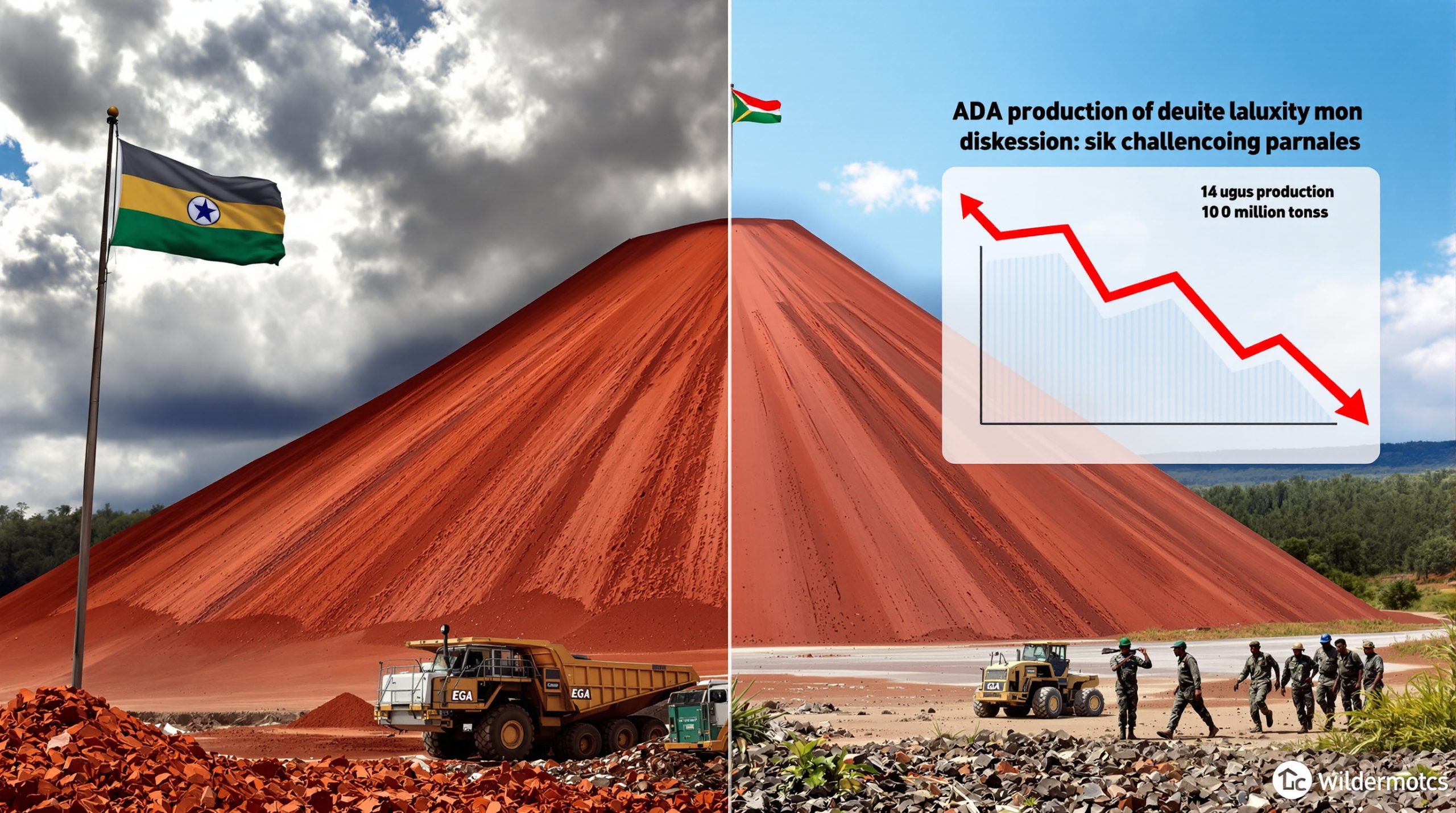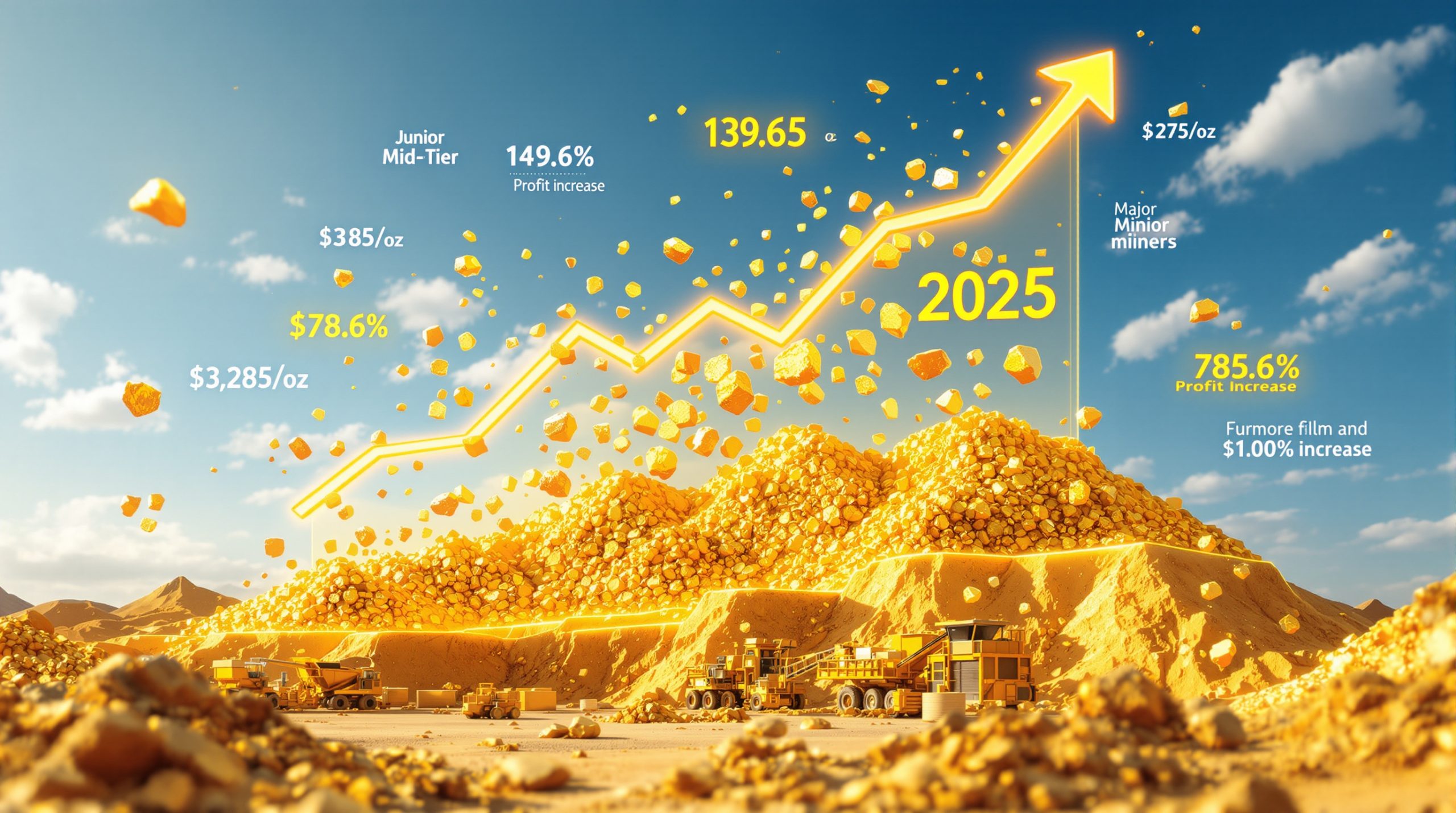Gold Mining and Exploration Trends: Industry Insights for 2025
The gold mining sector is undergoing a significant transformation in 2025, with several key trends emerging despite unprecedented market conditions. While record-high gold prices have created substantial profit margins for producers, the overall market sentiment remains surprisingly measured compared to previous bull markets—suggesting considerable growth potential still exists within the sector.
Market Sentiment vs. Fundamental Performance
Major gold mining companies are reporting exceptional earnings that rival or surpass many technology sector darlings, yet investor enthusiasm hasn't fully caught up to the sector's fundamental strength. As Euan Downey, a company builder with over 25 years of experience, notes: "Despite gold at all-time highs, I think it's still pretty subdued." This disconnect between performance and perception creates potential opportunities for investors who recognize the underlying value.
Gold producers are "knocking it out of the park" with their earnings reports. To put this in perspective, Downey points out that companies like "Agnico makes way more money than Tesla does at just a fraction of the market cap." This stark contrast highlights how undervalued gold stocks remain despite their strong financial performance.
Institutional investors, particularly in the US, are only beginning to allocate capital to the gold mining sector. This gradual shift in investment patterns could provide additional upward momentum as more institutional money flows into mining stocks.
Technical Innovation in Exploration
The gold exploration landscape is evolving with technological advancements helping companies identify previously overlooked deposits. Advanced visualization techniques allow explorers to reinterpret historical data and discover new opportunities in areas previously considered exhausted or unprospective.
Intrusion-related gold systems are receiving increased attention from exploration companies. These geological settings, characterized by their association with igneous intrusions, offer promising targets for companies seeking substantial gold deposits.
Massive sulfide deposits with gold components have also become priority targets for many explorers. These polymetallic deposits can offer significant value beyond their gold content, providing additional revenue streams and economic resilience.
The integration of historical data with modern exploration techniques is yielding promising results across many districts. Companies that can effectively combine decades of previous work with cutting-edge technology often gain a competitive advantage in identifying new resource opportunities.
How Are Junior Mining Companies Navigating the Current Market?
Junior mining companies face unique challenges and opportunities in today's environment. While access to capital remains a significant hurdle for many, companies with quality assets and experienced management teams are finding innovative ways to advance their projects without excessive dilution.
Capital Acquisition Strategies
Strategic partnerships with major producers provide crucial funding and technical expertise for junior companies. These relationships allow smaller players to benefit from the financial resources and operational knowledge of established miners while maintaining meaningful project ownership.
Joint venture models enable juniors to leverage outside capital while preserving upside exposure. As Downey explains, "I dig it over other people's money. So the joint venture model" offers advantages for exploration-stage companies looking to minimize dilution while continuing to advance projects.
Companies with strong leadership teams consistently attract capital even in challenging market conditions. Investors recognize that experienced management with previous successes often represents the most critical factor in a junior company's potential for value creation.
Successful capital raises frequently depend on management's track record of previous exits and demonstrated ability to create shareholder value. This emphasis on proven performance has become increasingly important as investors become more selective in their resource sector allocations.
Project Development Approaches
Many junior companies now focus on brownfield exploration near existing infrastructure to reduce capital requirements. This approach minimizes the upfront investment needed while accelerating potential pathways to production.
District-scale land packages offer exploration upside beyond initial discoveries. Companies controlling large, prospective areas can systematically explore multiple targets while potentially increasing their attractiveness as acquisition candidates.
Mining-friendly jurisdictions have become increasingly important for project selection as companies seek to minimize permitting risks. The regulatory environment can significantly impact development timelines and project economics, making jurisdiction a critical consideration.
Technical feasibility and infrastructure access have emerged as crucial evaluation criteria for project advancement. Junior companies must demonstrate realistic development pathways that account for practical considerations beyond simple resource delineation.
What Makes a Gold Developer Attractive for Investment?
Gold developers—companies with defined resources but not yet in production—present unique investment opportunities with specific evaluation metrics that help identify potentially undervalued candidates.
Economic Study Evaluation
Preliminary Economic Assessments (PEAs) provide initial project economics but come with significant limitations that investors must understand. These studies typically have +/- 50% accuracy, making them useful starting points but not definitive valuations.
PEAs often use optimistic assumptions regarding metal prices and costs that may not reflect market realities. As one industry expert noted in a recent podcast, IM Gold's Côté Lake PEA used $1,200 gold in 2017 with a $1 billion capital expenditure estimate that ultimately ballooned to $3.5 billion—highlighting the potential for significant discrepancies between early estimates and final costs.
Many economic studies inadequately account for inflation or country risk, potentially overstating project economics. As industry veteran Matt Wilson points out, "Inflation is rarely a sensitivity and it gets outdated very quickly as you move the commodity price but not inflation."
Discount rates in economic studies frequently underestimate project risk, with many using rates around 5-6%. Wilson describes this as essentially a "risk-free rate, which is nonsense in venture capital," suggesting that more appropriate discount rates would better reflect the true risk profile of mining development projects.
Key Financial Metrics to Assess
Internal Rate of Return (IRR) serves as a critical indicator of project viability, with successful projects typically needing 30%+ to account for real-world risks. Lower IRRs suggest insufficient returns given the inherent uncertainties of mine development. As CJ Kim notes when discussing appropriate IRR thresholds, "You want to find something higher, right? 30%."
Payback period represents another vital metric, as faster payback reduces risk exposure. Projects that can return their initial capital investment quickly provide investors with greater certainty and reduced vulnerability to commodity price fluctuations or operational challenges.
NAV to CAPEX ratio helps identify projects with more favorable risk-reward profiles. Higher ratios (3:1 or better) indicate projects that generate substantial value relative to their required investment, creating a more attractive proposition for both investors and potential acquirers.
Market cap to NAV ratio provides insight into valuation, with developers typically trading at approximately 0.2x their stated NAV. This discount reflects the risks and time required to advance from economic studies to actual production.
Risk Assessment Factors
Capital expenditure requirements relative to company market capitalization indicate financial feasibility. When development costs significantly exceed a company's current market value, obtaining financing becomes increasingly challenging without substantial dilution.
Permitting pathway complexity and timeline dramatically impact project advancement. Understanding the regulatory requirements and historical precedents in a given jurisdiction helps assess the likelihood of successful and timely permitting.
Infrastructure access and requirements can significantly affect development costs and timelines. Projects requiring substantial new infrastructure development face additional capital needs and potential delays compared to those with existing access to power, water, and transportation networks.
Management team's track record of advancing similar projects provides valuable insight into execution capability. Companies led by experienced teams with previous development successes typically face fewer operational surprises and demonstrate greater efficiency in project advancement.
How Are Consolidation Trends Shaping the Gold Sector?
The gold mining industry is experiencing significant consolidation activity, particularly among developers and explorers. This trend creates both challenges and opportunities for investors navigating the sector.
Acquisition Targets and Valuation
Companies with high-quality assets in established mining districts attract premium valuations in acquisition scenarios. Strategic location and resource quality remain primary drivers of acquisition interest and transaction multiples.
Projects with existing infrastructure or proximity to operating mines become priority targets as they offer potential operational synergies and reduced development costs for acquirers. These advantages can translate into premium valuations during consolidation events.
Silver developers and explorers are experiencing particularly active consolidation. As CJ Kim observes, "We're seeing a lot of consolidation in that specific space. A lot of silver developers and even explorers getting gobbled up right now," highlighting increased merger and acquisition activity in this subsector.
Companies with strong management teams and derisked projects command higher premiums during takeover negotiations. Acquirers recognize the value of both quality assets and the teams capable of developing them efficiently.
Strategic Positioning for Potential Takeovers
District consolidation creates more attractive acquisition targets by allowing acquirers to establish dominant positions in prospective areas. Companies that systematically consolidate land positions within productive districts often become natural acquisition candidates.
Strong relationships with major producers can create built-in potential acquirers. Junior companies that establish productive partnerships through joint ventures or other collaborative arrangements sometimes find these relationships evolving into full acquisition scenarios.
Assets in jurisdictions with established permitting pathways reduce acquisition risk for potential buyers. The predictability of regulatory processes and timelines makes these projects more attractive acquisition candidates compared to those in less certain regulatory environments.
Projects with multiple development options provide flexibility for potential acquirers to optimize based on their specific operational needs and capital availability. This optionality can enhance a project's attractiveness during consolidation discussions.
What Role Do Joint Ventures Play in Gold Exploration?
Joint ventures have emerged as an important strategy for exploration companies to advance projects while managing risk and capital requirements. This collaborative approach offers several advantages for companies at various stages of development.
Benefits of Joint Venture Models
Joint ventures allow junior companies to leverage partners' financial resources, enabling exploration programs that might otherwise be impossible to fund independently. This "other people's money" approach, as Downey describes it, helps preserve equity while advancing projects.
Access to technical expertise from larger partners represents another significant advantage of joint venture arrangements. Junior companies can benefit from the geological, engineering, and operational knowledge of more established miners.
The ability to explore multiple projects simultaneously through different joint venture partnerships enables companies to diversify their project portfolio and increase their chances of discovery success. This approach spreads risk across multiple opportunities.
Reduced dilution compared to equity financing makes joint ventures particularly attractive in challenging capital markets. By securing project-level funding through partners rather than issuing new shares, companies can maintain stronger ownership positions for shareholders.
Joint Venture Structure Considerations
Ownership percentages and earn-in requirements form the foundation of joint venture agreements. These terms define how project interest is allocated and under what conditions partners can increase their ownership positions.
Operator designation and decision-making authority significantly impact project advancement. The party designated as operator typically controls day-to-day activities and technical direction, making this role particularly important.
Technical committee composition and oversight mechanisms help ensure all partners maintain appropriate input and control over project development. Well-structured committees balance the interests of all parties while maintaining operational efficiency.
Future development and financing obligations must be clearly defined to avoid potential conflicts as projects advance. Comprehensive agreements address not only exploration activities but also subsequent development scenarios and funding responsibilities.
How Do Economic Studies Impact Gold Project Valuation?
Economic studies play a crucial role in project valuation but require careful interpretation due to their inherent limitations and optimistic assumptions. Investors must understand these constraints to properly evaluate a project's true potential.
Understanding PEA Limitations
Preliminary Economic Assessments can use inferred resources (lower confidence) in economic calculations, potentially overstating project economics. Unlike more advanced studies, PEAs can incorporate these less certain resource categories in their financial models.
Gold price assumptions vary widely between studies and rarely account for price volatility. Using static price assumptions fails to capture the cyclical nature of commodity markets and potential downside scenarios.
Inflation assumptions are often inadequate or missing entirely from economic studies. As Wilson notes, inflation "gets outdated very quickly as you move the commodity price but not inflation," creating potential disconnects between projected and actual economics.
Discount rates in economic studies rarely reflect true project risk, with many using rates more appropriate for established businesses than speculative mining developments. This methodological choice can significantly overstate project value, especially for longer-life operations.
Moving Beyond PEA Stage
Pre-Feasibility Studies provide more reliable estimates (+/- 25%) based on more detailed engineering and higher confidence resource classifications. This intermediate stage offers substantially improved accuracy over preliminary assessments.
Feasibility Studies represent the highest confidence level (+/- 15%) and typically form the basis for final investment decisions. These comprehensive studies incorporate detailed engineering, procurement estimates, and thorough technical analysis.
Engineering studies become outdated quickly as input costs change, requiring regular updates to maintain relevance. Capital and operating cost estimates from even a few years ago may no longer reflect current market conditions.
Sustaining capital requirements are often underestimated in early studies, potentially creating significant discrepancies between projected and actual project economics. These ongoing investments to maintain operations represent a crucial component of total project costs.
What Geographic Regions Show Promise for Gold Exploration?
Certain regions stand out for their exploration potential and favorable operating environments, with both established districts and emerging frontiers offering opportunities for resource development.
Established Mining Districts
The Abitibi Greenstone Belt in Canada continues to yield significant discoveries despite its long production history. As Downey notes, some companies control "one of the largest single contiguous properties in all of the Abitibi Quebec," highlighting the ongoing exploration potential in this prolific region.
Nevada maintains its position as a premier jurisdiction for gold exploration and development. The state has produced "phenomenal" 100-meter intercepts of one gram gold as mentioned by Downey, demonstrating the continued potential for substantial discoveries.
The Sierra Madre Occidental trend in Mexico offers high-grade silver-gold potential with a long history of productive mining operations. This metallogenic belt continues to attract exploration investment despite jurisdictional challenges.
Western Australia remains a global gold exploration hotspot with its combination of prospective geology, established infrastructure, and supportive mining regulations. The region continues to produce significant new discoveries despite extensive previous exploration.
Emerging Exploration Frontiers
States with recently changed mining regulations present new opportunities for resource development. Wisconsin, for example, "changed a moratorium that precluded mining for 20 years about 5 years ago," according to Downey, potentially opening previously restricted areas to exploration.
Underexplored regions with historical production show renewed potential as modern exploration techniques allow companies to revisit areas previously considered exhausted. These "brownfield" opportunities often benefit from existing infrastructure and known mineralization.
Areas with existing infrastructure but limited modern exploration techniques offer attractive development scenarios with reduced capital requirements. The combination of established access and untested exploration potential creates compelling investment opportunities.
Jurisdictions implementing more streamlined permitting processes attract increased investment as companies seek to minimize regulatory delays and uncertainties. Regulatory predictability significantly impacts project timelines and economics.
How Are Technical Factors Influencing Gold Project Success?
Technical considerations increasingly determine which projects advance to production as capital constraints and margin pressures focus attention on operational feasibility and economic robustness.
Critical Technical Factors
Metallurgical recovery rates significantly impact project economics, sometimes outweighing grade in importance. Lower-grade deposits with simple metallurgy and high recoveries can outperform higher-grade projects with complex metallurgical challenges.
Infrastructure requirements affect capital costs and development timelines. Projects requiring substantial new infrastructure development face higher initial investments and longer paths to production compared to those with existing access.
Deposit geometry and mining method influence operating costs and project feasibility. The physical characteristics of a deposit—including its shape, orientation, and continuity—dictate appropriate mining approaches and associated economics.
Environmental considerations shape permitting timelines and requirements, with water management often representing the most significant challenge. Projects with potential impacts on water resources face increased scrutiny and more complex permitting processes.
Technical Due Diligence Focus Areas
Resource classification confidence (measured, indicated, inferred) provides insight into geological certainty and development risk. Higher-confidence resource categories support more reliable economic assessments and financing discussions.
Metallurgical test work comprehensiveness indicates potential processing challenges or opportunities. Thorough metallurgical programs that address variability across the deposit provide greater certainty regarding recoveries and processing costs.
Geotechnical stability assessments impact mining approach and operational safety. Understanding ground conditions helps determine appropriate mining methods and required support systems, directly affecting both capital and operating costs.
Water management requirements and solutions often represent critical permitting and operational considerations. Projects must demonstrate sustainable approaches to water use, treatment, and discharge to satisfy regulatory requirements and maintain social license.
What Investment Approaches Work Best in the Current Gold Market?
Different investment strategies can be employed depending on risk tolerance and investment objectives, with the gold sector offering opportunities across the risk-reward spectrum.
Risk-Reward Spectrum Considerations
Producers offer lower risk but typically less leverage to gold price increases. These established companies provide operational stability and often dividend income, but with more modest appreciation potential during bull markets.
Developers provide a balance of defined resources with significant upside potential. Companies with established resources but not yet in production offer meaningful leverage to rising gold prices while maintaining more certainty than early-stage explorers.
Explorers offer maximum leverage but with corresponding higher risk of failure. These early-stage companies provide the greatest potential returns but require substantial risk tolerance and portfolio diversification.
Royalty companies provide sector exposure with reduced operational risk compared to miners. This business model offers participation in project upside while avoiding many of the direct challenges associated with mine development and operation.
Portfolio Construction Strategies
Core positions in established producers create portfolio stability and often provide dividend income. These companies offer direct exposure to current gold prices through existing operations.
Strategic allocations to advanced developers trading at discounts to NAV provide potential for significant appreciation as projects advance toward production. The typical discount of approximately 0.2x NAV creates substantial upside potential if development proceeds successfully.
Speculative positions in explorers with exceptional technical merit allow participation in discovery upside. While higher risk, these investments offer exponential growth potential when successful.
Diversification across jurisdictions and development stages helps manage risk while maintaining sector exposure. This balanced approach allows investors to participate in various aspects of the gold market surge while reducing vulnerability to project-specific setbacks.
FAQ: Gold Mining and Exploration Investment
What is the significance of visible gold in drill core?
While visible gold creates excitement, it doesn't necessarily indicate economic mineralization. The distribution, continuity, and overall grade of mineralization matter more than spectacular visual results. However, visible gold can signal high-grade zones within a larger system, potentially enhancing project economics in certain areas.
How important is management experience when evaluating junior miners?
Management experience represents perhaps the most critical factor when evaluating junior companies. Teams with previous success in discovering, developing, and monetizing projects tend to repeat these successes. Look for executives with technical expertise, capital markets experience, and a demonstrated track record of creating shareholder value through previous ventures.
What makes a PEA reliable versus potentially misleading?
More reliable PEAs use conservative metal price assumptions, incorporate realistic recovery rates based on comprehensive metallurgical testing, apply appropriate discount rates reflecting project risk (well above the typical 5-6%), and include adequate contingencies for capital and operating costs. Be particularly cautious of studies using optimistic pricing or inadequate inflation factors.
How do joint ventures impact shareholder value for junior explorers?
Joint ventures can enhance shareholder value by providing access to capital without equity dilution, accelerating project advancement through partner expertise, and validating project quality through partner investment. However, they also reduce the junior's ownership percentage and potential upside in the event of a major discovery, creating a tradeoff between risk reduction and reward potential.
What factors most commonly derail mining project development?
The most common factors that derail projects include permitting delays or denials, capital cost escalation beyond initial estimates, metallurgical challenges emerging during detailed testing, and infrastructure limitations that weren't adequately addressed in early studies. Social license issues and changing tax/royalty regimes can also significantly impact project economics and development timelines.
With gold mining and exploration trends constantly evolving, investors should stay informed about the latest gold price forecast and consider diverse gold investment strategies to capitalize on the sector's opportunities while managing its inherent risks.
Ready to Catch the Next Major Gold Discovery?
Don't miss out on potential investment opportunities like those highlighted in this article. Discovery Alert's proprietary Discovery IQ model provides real-time notifications when significant mineral discoveries are announced on the ASX, giving you a crucial market advantage. Visit https://discoveryalert.com.au/discoveries/ to see how historic discoveries have delivered exceptional returns for early investors.




